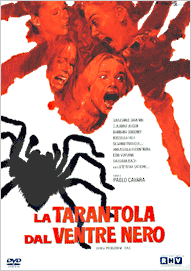(aka LA TARANTOLA DAL VENTRE NERO)
(1971,Italy)

Perhaps unsurprisingly for a giallo, there’s a killer on the loose! However, in THE BLACK BELLY OF THE TARANTULA there’s a twist in the tail – or, perhaps, that should be a twist in the sting. Someone is stalking the exclusive customers of a swanky health spa in classic giallo garb (raincoat and fedora are all present and correct, only with surgical gloves adding a kinky twist (and one that was repeated in the fairly obscure Canadian slasher from the early 80s, AMERICAN NIGHTMARE)). The killer offs the victims with a regulation blade, but before the deadly deed is done an acupuncture needle is inserted into their neck, rendering them paralyzed but also fully aware of their fate and their assassins’ ghoulish work.

The first victim is Maria Zani (Barbara Bouchet), a nymphomaniac who tries it on with a blind masseuse during the opening credits, whilst relaxing at the spa. Afterwards, she has a fight with her estranged husband (Silvano Tranquilli), who has been sent a photo of her getting it on with an unidentified young man, she is attacked by the killer at her home and has her belly slit open after being paralyzed with the needle (somewhat mirroring Hitchcock’s PSYCHO (1960), where a seemingly obvious female protagonist is offed early on in the film).

Inspector Tellini (Giancarlo Giannini) is called to investigate the case after Maria’s body is found. Naturally, at first Tellini suspects her husband; especially when a friend of Maria’s unwittingly destroys his alibi. However, there is also the matter of the photograph, which has been torn in two; it shows the arms of a man who is not her husband holding a naked Maria. The husband seems to be even guiltier when he appears to vanish, but things aren’t quite what they seem. Another girl is slain in an identical manner to Maria at an exclusive fashion boutique. When a large quantity of drugs are found at the shop Tellini has to discover the common link between the two murders to find the killer and prevent more bodies piling up …
Rather gruesomely, the killer’s method is based on the way a certain type of wasp attacks a tarantula, paralyzing it with its poison before cutting open the spider’s belly and planting its eggs there so that the grubs eat the unfortunate insect alive. So gruesome, in fact, is the case that a world-weary Tellini tells his wife that he’s seriously considering giving up the police force. However, as the body-count inevitably increases he finds himself drawn inexorably further into a web of intrigue as danger strikes uncomfortably close to home.

In THE BLACK BELLY OF THE TARANTULA, the health spa replaces the fashion house as the ubiquitous giallo setting, which naturally provides plenty of opportunity for glamorous ladies swanning around with not much on. It is a prime giallo, but it’s not quite classic material. Like THE FIFTH CORD (1971), there’s a certain tang of the art-house about it. Not that that’s necessarily a bad thing, but it sits oddly ill at ease with the more exploitative aspects on show. Also, some faltering action and uneven pacing don’t help, especially around a rather flabby middle section.
The film is, however, bolstered by a wonderfully naturalistic performance by Giannini as the lackadaisical cop, who finds events spiraling out of control around him – the classic giallo hero. He also appeared in an earlier example of the genre, LIBIDO (1965), and more recently in HANNIBAL (2001). Surprisingly, though, it seems that a good deal of the running time is spent with him discussing with his wife, Anna (Stefania Sandrelli), the prospect of selling the furniture in their apartment. Hardly the stuff thrillers are made of!

Luckily, as the seemingly disparate drugs (cocaine cleverly smuggled in protected by tarantulas!) and blackmail plots segue together the film picks up its pace, and there’s an especially exciting rooftop chase sequence similar to the one in Argento’s CAT O’ NINE TAILS (also 1971). There are also shades of other great giallo directors, most notably Mario Bava with an extended scene where one victim finds herself incapacitated by mannequins as she flees a murderous advance. The film is also ably aided by a particularly nervy and abstract Morricone score, which compliments the prowling camera and sinister work of the killer.
Familiar faces, Barbara Bach (SHORT NIGHT OF THE GLASS DOLLS (1972)) and Rosella Falk (SEVEN BLOODSTAINED ORCHIDS (1972)) turn up as potential victims for the killer’s flashing blade. Plus, eagle-eyed viewers may recognise Walter Eugene, as a camp waiter at the spa, who played a more sinister character in Pupi Avati’s masterful HOUSE WITH THE LAUGHING WINDOWS (1976).
Naturally, like all the best gialli, THE BLACK BELLY OF THE TARANTULA is topped off with a pleasingly nonsensical and outrageous twist ending. It’s not the best example by a long stretch but it has enough 70s style, blood ‘n’ blades and giallo craziness to be on the must-see list of any aficionado of the genre.
BODYCOUNT 7  female:5 / male:2
female:5 / male:2
1) Female paralyzed and sliced with
knife
2) Female paralyzed and stabbed with
knife
3) Male hit and killed by car
4) Female paralyzed and stabbed with
knife
5) Female found stabbed to death
6) Male has head repeatedly bashed
against a wall